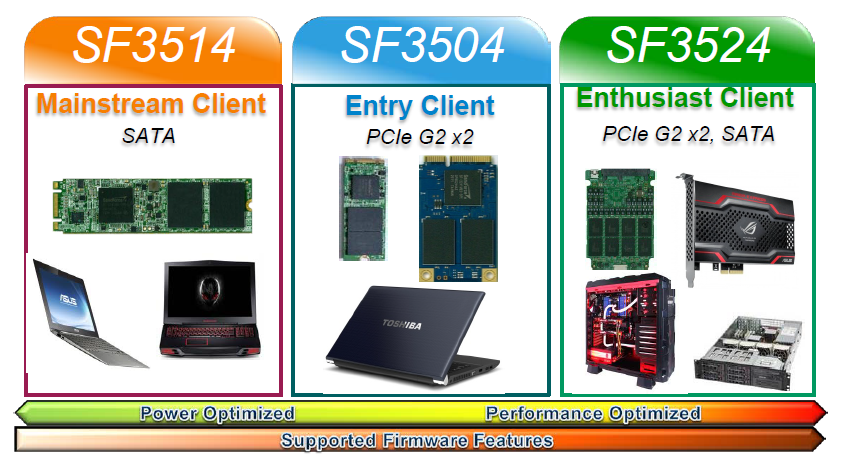Seagate SandForce SF3500 Client SSD Controller Detailed

Do you have a SATA Express slot unpopulated on your shiny new X99 or Z97 motherboard? We all do. The new interface capable of delivering 10 Gbps of bandwidth was designed for client SSDs, but more specifically, it was designed for SandForce products that should have shipped with the Z97 chipset generation.
Yesterday we sat down with Kent Smith, who ping ponged from SandForce to LSI SandForce to Avago and finally to the SandForce division at Seagate. While bouncing back and forth, the SF3000 product team was forced to accept massive delays, but it looks like the company is nearing the final stages of R&D.
The newly announced SF3500 is the client arm of the SF3000 product family, with SF3700 taking the enterprise role. SF3500 further separates into three products optimized for specific use cases.
The SF3514 product is highly optimized for low power consumption in mainstream mobile devices. This controller supports only SATA with the AHCI protocol and delivers 4-channel paths to the NAND flash.
Moving up a step, but for some odd reason moving down in product number, is the SF3504. This is also a mainstream component that uses PCIe 2.0 x2. There is another notebook, Ultrabook, small form factor specific controller that also utilizes 4-channels to deliver the best performance in power restricted environments, such as notebooks on battery.
Finally, we have the SF3524 that will ship in both SATA 6 Gbps and PCIe 2.0 x2 products. A majority of the future products we'll test here at Tom's Hardware come from this controller, where performance is optimized over power consumption.

The SF3500 product family uses four channels to interface with flash, but several of the SF3700 features carry over.
Get Tom's Hardware's best news and in-depth reviews, straight to your inbox.

This is the first SandForce controller to use a DRAM buffer to cache table data. Sadly, the parity package used to combat a full die failure is not supported on the SF3500, which was one of the standout features from the SF3700. Still, the SF3000 controller series is the most advanced SSD controller ever made.

Once available, the SF3000 product series will enjoy a long product lifecycle like the SF2000 products before it. SandForce released the SF2000 in 2010, but you can still buy client and enterprise product today with the technology.
The secret to SandForce's longevity has always been the same. The controllers are designed to support a vast range of NAND flash that not only covers current technologies, but also products far beyond the current horizon. The new modular design takes future support out even further than any other product SandForce has created in the past.
In the coming weeks we will release a full report on the current state of SF3000, with all of the detailed SF3700 and SF3500 product family information. Retail products should appear just after Flash Memory Summit in August.
Chris Ramseyer is a Contributing Editor for Tom's Hardware, covering Storage. Follow him on Twitter and Facebook. Follow Tom's Hardware on Twitter, Facebook and Google+.
-
RamCity Does sandforce think there is a big enough installed base of systems out there which warrants investing in another PCIe 2.0 x2 controller? Or maybe it's because they have invested so much in developing it, but due to the release delays they are now faced with putting out a product to a market that is demanding PCIe 3.0 x4?Reply
I'd be interested to know the logic behind their decision not to dump the SF3504. Perhaps there is enough SSD manufacturers that are willing to continue betting on PCIe 2.0 x2 and so need that controller.
